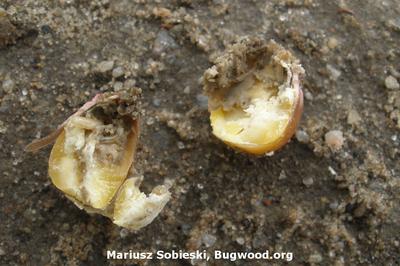Onion Maggots
Delia platura
Insect
In a Nutshell
- Maggots feed on sprouting seedlings and seeds, damaging the growing tissues. Seedlings develop into withered, stunted, deformed plants with low yields.
Can also be found in
Symptoms
Maggots feed on organic matter in the soil and on sprouting seedlings. They also burrow into the seeds, often destroying the growing tissues and preventing germination. If they develop at all, there is clear damage from the maggots’ feeding visible on the young leaves. Rot of tissues can ensue. Seedlings may develop into withered, stunted, deformed plants which give few seeds with low quality and consequently low yields. If soils are wet and if there are prolonged periods of cool weather and high humidity, the damage can be significant.
Recommendations

Organic Control
Due to its underground life, seedcorn maggots do not appear to have a great number of natural enemies. However, predation by ground beetles, spiders and birds on adults does occur. The larvae can be affected by fungus diseases. However, predators as well as fungal diseases do not provide sufficient control. The flies are naturally attracted to bright colors, so they can be trapped in bright buckets with soapy water.

Chemical Control
Always consider an integrated approach of both preventive measures along with biological treatments if available. Seeds can be treated with an insecticide to ward off the maggot. Pesticides can be used, but be aware of the restrictions in your country. Soil-applied insecticides can also be used.
What caused it?
Symptoms are caused by the maggots of the flies Delia platura and D. antiqua. The adults resemble house flies in color, but they are smaller and more slender. They overwinter in soil close to old roots and plant debris. Adults emerge in spring as early as seeds are being planted. Females lay their eggs in moist soils that contain large quantities of decaying material or manure. Yellowish-white, legless larvae hatch after about a week and then start to eat on decaying organic matter and on seedlings. Damage is greater in cool, wet weather conditions which favor the life cycle of the pest and its feeding activity. Warm and sunny weather in turn hinders the deposition of eggs and also makes plants grow faster and hardier.
Preventive Measures
- Plant in dry soils with little organic content.
- Ensure shallow planting during warm and sunny weather.
- If applying manure, wait some weeks before planting.
- Use cover crops such as grasses.
- Handle the seeds with care so that you don't injure them.
- Destroy weeds in and around the fields.
- A fine mesh net on your seedbed keeps the maggot flies away.
- Plow and bury plant debris deep into the soil.



